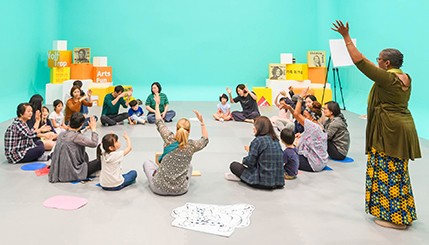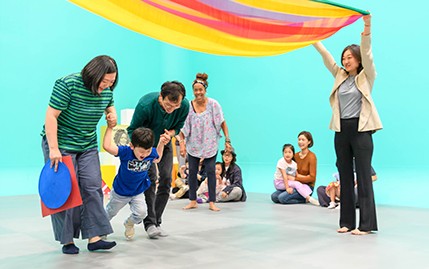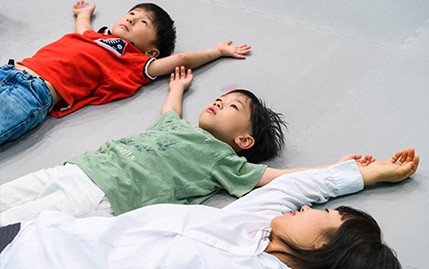KACES Newsletter Vol.11
2019
July 26
July 26
© 2019 KACES
COLUMN
The Lullaby Project in Korea
In March of this year (2019), I had the pleasure of meeting a group of artists preparing to initiate the Lullaby Project in Korea. Though it was through our laptops rather than in person, we still had a lively exchange about what to expect and how to deal with the unexpected in creating music with young families. I am very excited about the prospects of continuing to connect with these artists, part of one of the largest groups of teaching artists in the world. KACES is giving its support and its focus on early childhood teaching this year, and it seems like a happy bit of karma. The feeling in the air is right for lullaby!
The Lullaby Project is now an international community that was born in a tiny room in a hospital in New York City. Here’s the story. In 2011, with support from Carnegie Hall, I was leading songwriting workshops at Jacobi Hospital in the Bronx. It was a 12-week residency for teenagers who were experiencing challenges with their chronic HIV diagnosis. We met once a week and wrote songs. We talked about what they wanted to say, played games and wrote stories. These stories turned into lyrics, and then the teens wrote music, with help from our group of teaching artist/musicians. Once we finished the songs, we performed them at a midday concert at the hospital. The concert was a real celebration of the kids and their new songs, and when it was over we were approached by a nurse and a social worker who worked in maternal health. They asked if we would consider doing similar work with pregnant teens. The explained that these teenagers often had difficulty attaching with their babies, and they wondered if writing songs might help.
This suggestion collided with a lifelong interest of mine. Ever since I began writing music, I have enjoyed learning and writing lullabies. There were lullabies in plays that I wrote music for, and there were lullabies I arranged for concerts. I gave lullabies as gifts to friends who were having babies, and I loved creating customized, “bespoke” lullabies with the names of the children embedded. “Yes,” I said to the nurse, “I think songwriting could help; what about lullabies?”
That was enough to get a conversation going with the staff at the hospital, and with help from Sarah Johnson, the director of the Weill Music Institute, we launched a lullaby pilot project. Our first meeting with teen moms was in a tiny room in the Obstetrics Department of the hospital. The moms were shy and a little mystified. No amount of explaining beforehand could really prepare them for the experience of writing their own lullaby, and I think that was true of the artists, too. We fashioned four lullabies over the span of two weeks, and we recorded them in a professional studio. The moms were excited to hear their words and tunes brought to life, and after the experience they all talked about the achievement of writing their own songs. It was our first lullaby collaboration, and we were off and running.
Eight years later, we have expanded to 15 local sites where lullaby creation is a habit. We have over 25 national and international partners who are also doing projects of their own, each with its own structure and personality. We convene each year in the late Spring in New York to perform the year’s most memorable and moving songs and to share promising practices from around the country and the world.
Here’s where I think there are fantastic opportunities for Korea. At Carnegie Hall, we have developed a particular set of practices, and we are proud of the work we are doing. But we are also interested in the many ways that other partners are adapting and customizing the work to their communities and their educational aspirations. For instance, in Austin, Texas, the Austin Classical Guitar Society has developed a lullaby project that includes teaching moms to play the guitar in an extended program that spans a year or more. That is not something we do at Carnegie Hall, but there is so much we are learning from their work. And in Eagle River, Alaska, at the Hiland Mountain Correctional Facility, the artists and staff there are developing a beautiful model of lullaby for incarcerated mothers. Again, though we do work with mothers in correctional facilities in New York City, we stand to learn a great deal from the artists in Alaska.
Each of these partners (and more, besides) has asked themselves an essential question: “how can lullaby serve our community in a way that is authentic to our mission and deeply meaningful to the young families with whom we collaborate?”
So, what can the lullaby work in Korea do? What are the contributions lullaby can make to the particular social issues facing young families in Korea today? What can the artists contribute, and how can organizations like KACES support lullaby creation in ways that are both innovative and meaningful? There is no simple answer, no cookie-cutter solution that guarantees if you carry out the program in one way it will always work. It takes research, experimentation, and practice to begin to formulate the right questions for Korean lullaby work.
Once the formative stages of the work are underway, there will be an opportunity to forecast and to dream. Looking at the teaching artist forces in Korea, it is hard not to hope for a day when KACES could use the scale of its networks to make lullaby available across the country. Right now, in the United States, we have not yet been able to locate the right kind of “carrier” for lullaby to make it a widely available opportunity. Could it happen in Korea? If it could, it would be instructive for us and for all our partners, too.
Of course, lullaby might not become a national program in Korea, nor does it need to in order to be successful. Good quality work in discrete projects has its value, too. But Korea is already showing real leadership in training teaching artists and making arts education a valued part of its national education programs. Its international leadership is evident in its hosting ITAC5 in 2020. What can Korea contribute to lullaby? We cannot wait to find out.
Carnegie Hall Lullaby Project link:
https://www.carnegiehall.org/Education/Social-Impact/Lullaby-Project
Lullaby: Being Together, Being Well
https://www.carnegiehall.org/-/media/CarnegieHall/Files/PDFs/Education/Social-Impact/Lullaby-Project/Wolf-Brown_Lullaby--Being-Together-Being-Well.pdf?la=en
Why Making Music Matters
https://www.carnegiehall.org/-/media/CarnegieHall/Files/PDFs/Education/Social-Impact/Lullaby-Project/WolfBrown_Lullaby_Why-Music-Matters.pdf?la=en
The Lullaby Project, Austin Classical Guitar
https://www.austinclassicalguitar.org/the-lullaby-project/
The Lullaby Project, Hiland Mountain Center, Eagle River, Alaska
http://keystolifeak.wpengine.com/?page_id=116
© 2019 KACES
Bring High-Quality Arts-Based Early Childhood learning to South Korea
In May 2019, Wolf Trap Institute for Early Learning Through the Arts had the pleasure of visiting South Korea in partnership with the Korean Arts & Culture Education Service (KACES) to participate in the International Arts Education Week (IAEW) and engage communities of children, parents, artists and educators with educational experiences based in the arts, and for benefit of early childhood learners.
In this article, you’ll read reflections from the members of the Wolf Trap Institute team who attended: Akua Kouyate-Tate, Vice President of Education, Wolf Trap Foundation for the Performing Arts; and Wolf Trap Institute Master Teaching Artists Christina Farrell, and Terlene Terry-Todd.
Akua Kouyate-Tate, Vice President of Education, Wolf Trap Foundation for the Performing Arts
The graciousness of our host at KACES in Seoul and Ulsan Arts and Culture Foundation in Ulsan made for a very gratifying and memorable arts education and cultural engagement in Korea. Our hosts provided an experience unlike what one might expect at a conference gathering. Our Wolf Trap team were invited in communities and early learning institutions to share early childhood arts learning with parents/caregivers and their children.
In this article, you’ll read reflections from the members of the Wolf Trap Institute team who attended: Akua Kouyate-Tate, Vice President of Education, Wolf Trap Foundation for the Performing Arts; and Wolf Trap Institute Master Teaching Artists Christina Farrell, and Terlene Terry-Todd.
Akua Kouyate-Tate, Vice President of Education, Wolf Trap Foundation for the Performing Arts
The graciousness of our host at KACES in Seoul and Ulsan Arts and Culture Foundation in Ulsan made for a very gratifying and memorable arts education and cultural engagement in Korea. Our hosts provided an experience unlike what one might expect at a conference gathering. Our Wolf Trap team were invited in communities and early learning institutions to share early childhood arts learning with parents/caregivers and their children.


Our exchange started at the Seoul Early Childhood Education & Promotion Center, and it was very evident that families and schools who attend the Center are surrounded by child-centered, interactive arts learning in this facility that mesmerizes the child in all of us, and would be considered a treasure of learning by most early childhood educators. The next day, we were welcomed to the Education Broadcasting System (EBS), a multimedia station that provides education programming throughout Korea. The EBS studio we visited was transformed to a colorful warm environment that stimulated the senses and set the stage for multi-sensory artful learning. Over the course of 2 days more than 120 parents/caregivers and children very willingly joined our Wolf Trap team in artful, joyous music, drama and dance/movement. The parents/caregivers with their children engaged in experiences they are able to do in their homes to inspire their children’s learning. The following strategies were shared with parents about how they are able to interact at home with their children in artful play that inspires children’s learning:
1) Keep a steady beat! It helps children speak, read and count.
2) Practice listening skills with musical games.
3) Introduce new words through songs, dances and story chants.
4) Use different body parts to demonstrate movement.
5) Describe and demonstrate locomotor/positional movements.
6) Describe sounds and emotions.
7) Create movement sequences to show ideas and create original dances.
8) Act it out! Children use their bodies and simple props to make meaning.
9) Engage your child’s imagination to explore music, movement and drama.
10) Have FUN together!
On our third day we joined a gathering of more than 400 people, including educators, parents, teaching artists, Korea government officials and administrators in the education and arts sectors along with other international guests for the opening IAEW Symposium. The IAEW Symposium and week-long activities provided a convening that welcomed opportunity to learn and share with colleagues across the globe --Italy, Finland, Japan, Singapore, and the US are a few of the countries from where arts education practitioners came to share their programs and approaches.
Our final 2 days allowed the Wolf Trap team to connect with a group of artists and educators in the city of Ulsan. From seasoned professional artists with more than 20 years to those being relatively new to the arts education field, the expertise of the group was significant. However, the full group immersed themselves wholeheartedly to experience Wolf Trap’s approach to arts integration to support instruction and learning for young children; and we shared with each other ways to expand our practices with new strategies for engaging young children in the arts.
The IAEW week allowed us to share, learn, experience and inspire learning in and through the arts for young children and families of Korea. A continuing thread throughout the week that all the Wolf Trap team echoed over and over again was how we so appreciated the sincerity of all the people with whom we were involved: our KACES hosts, our amazing translator, all of the organizing team members as well as the artists and communities’ members.
The KACES and Ulsan Arts and Culture Foundation teams, and the people of Korea graciously opened their communities, brought together artists, educators, families and children to experience and share how arts learning, particularly for our youngest world citizens, inspires and fosters communication, critical thinking, collaboration, cooperation and creativity. The hospitality, openness, and willingness we were shown provided a platform for all participants to convene together for the purpose of making connections and sharing best practices for how the arts enrich the lives of young children, and have the ability to bring us together. We all desire a world where our children are able to live, thrive and contribute as caring human beings. Learning and engaging in the arts certainly can be a catalyst for this. Throughout our experiences with KACES and the IAEW-- in our interactions, exchange and fellowship with artists, educators, administrators, children, and parents in Seoul and Ulsan-- we shared together how arts integration is a powerful teaching tool! The arts support instruction at home, in schools and communities; the arts enrich the lives of young children (and the adults who care for them), while helping to lay the foundation for young children’s school readiness and developing essential life skills.
1) Keep a steady beat! It helps children speak, read and count.
2) Practice listening skills with musical games.
3) Introduce new words through songs, dances and story chants.
4) Use different body parts to demonstrate movement.
5) Describe and demonstrate locomotor/positional movements.
6) Describe sounds and emotions.
7) Create movement sequences to show ideas and create original dances.
8) Act it out! Children use their bodies and simple props to make meaning.
9) Engage your child’s imagination to explore music, movement and drama.
10) Have FUN together!
On our third day we joined a gathering of more than 400 people, including educators, parents, teaching artists, Korea government officials and administrators in the education and arts sectors along with other international guests for the opening IAEW Symposium. The IAEW Symposium and week-long activities provided a convening that welcomed opportunity to learn and share with colleagues across the globe --Italy, Finland, Japan, Singapore, and the US are a few of the countries from where arts education practitioners came to share their programs and approaches.
Our final 2 days allowed the Wolf Trap team to connect with a group of artists and educators in the city of Ulsan. From seasoned professional artists with more than 20 years to those being relatively new to the arts education field, the expertise of the group was significant. However, the full group immersed themselves wholeheartedly to experience Wolf Trap’s approach to arts integration to support instruction and learning for young children; and we shared with each other ways to expand our practices with new strategies for engaging young children in the arts.
The IAEW week allowed us to share, learn, experience and inspire learning in and through the arts for young children and families of Korea. A continuing thread throughout the week that all the Wolf Trap team echoed over and over again was how we so appreciated the sincerity of all the people with whom we were involved: our KACES hosts, our amazing translator, all of the organizing team members as well as the artists and communities’ members.
The KACES and Ulsan Arts and Culture Foundation teams, and the people of Korea graciously opened their communities, brought together artists, educators, families and children to experience and share how arts learning, particularly for our youngest world citizens, inspires and fosters communication, critical thinking, collaboration, cooperation and creativity. The hospitality, openness, and willingness we were shown provided a platform for all participants to convene together for the purpose of making connections and sharing best practices for how the arts enrich the lives of young children, and have the ability to bring us together. We all desire a world where our children are able to live, thrive and contribute as caring human beings. Learning and engaging in the arts certainly can be a catalyst for this. Throughout our experiences with KACES and the IAEW-- in our interactions, exchange and fellowship with artists, educators, administrators, children, and parents in Seoul and Ulsan-- we shared together how arts integration is a powerful teaching tool! The arts support instruction at home, in schools and communities; the arts enrich the lives of young children (and the adults who care for them), while helping to lay the foundation for young children’s school readiness and developing essential life skills.


© 2019 KACES